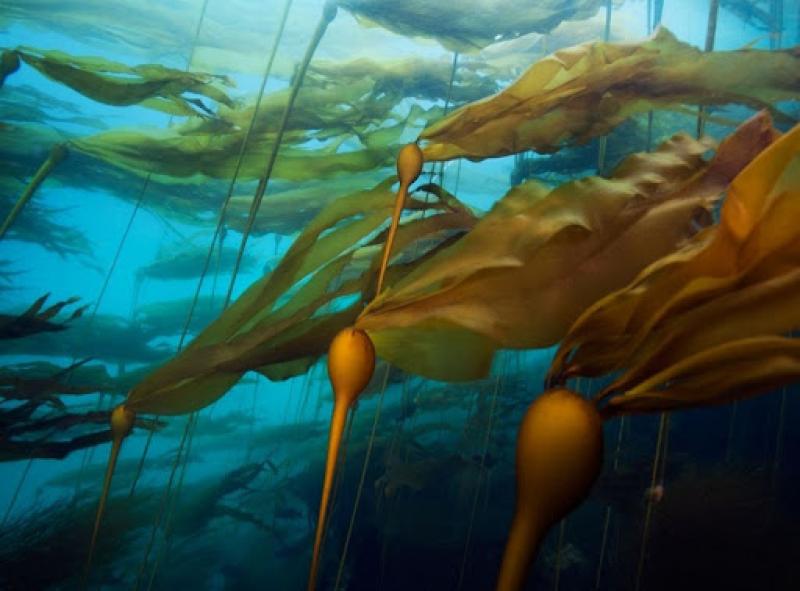The Alaska Fisheries Science Center released its new strategic research plan for shellfish and seaweed aquaculture in Alaska. This strategic research plan will be used to guide science center aquaculture-related research over the next 5 years. It will provide needed information for state and federal regulatory agencies and coastal communities in Alaska. It supports NOAA Fisheries efforts to ensure a sustainable seafood supply and economic opportunities for U.S. citizens.
“This science will support the state and NOAA's efforts to promote shellfish and seaweed production to stimulate job growth and ensure resilient coastal communities. This research will provide an important foundation for sustainable development,” said Bob Foy, Alaska Fisheries Science Center Director. “Marine aquaculture contributes to restoration efforts in Alaska, and is increasing economic opportunities for coastal communities through the farming of shellfish and seaweed.”
As of January 2022, the Alaska aquaculture industry is relatively small-scale, consisting of around 82 permitted farms. Another 24 farms have permits pending. The combined economic value of the industry is around $1.5 million.
At present, commercial aquaculture operations have largely focused on Pacific oysters, kelp, and blue mussel production in state waters. Finfish aquaculture is prohibited. The main regions of aquaculture development in Alaska are Southeast and Southcentral (Prince William Sound, Kenai Peninsula, and Kodiak).
However, NOAA Fisheries is interested in increasing shellfish and seaweed production for the long-term benefit of Alaska’s economy, environment, and communities. The state of Alaska hopes to build a $100 million per year industry to promote job growth and marine resource products in state waters over the next 20 years.
“We have an obligation to provide supporting science and research for federal policy-making and regulation. Our research can help ensure that aquaculture that is taking place in the state is conducted in a manner that doesn’t pose a risk to essential fish habitat, wild populations, subsistence subtidal and tidal harvest, marine mammals and commercial and recreational fisheries in coastal areas,” said Jordan Hollarsmith, Alaska Fisheries Science Center Aquaculture Research Lead. When done right, aquaculture can provide important ecological services such as water filtration, habitat provisioning, and potentially buffering against acidification in coastal environments. It can also create economic stimulation through the creation of jobs and eco-tourism.
Research Plan Highlights
This research plan focuses on seaweed (kelp and red algae), shellfish (Pacific oysters, pinto abalone, king crab), and other invertebrates (sea cucumber).
Research priorities include:
- Promote sustainable industry growth through monitoring and improved understanding of ecosystem interactions
- Promote economically and socially sustainable growth by increasing the portfolio of species grown in Alaska, focusing on endemic species and multitrophic aquaculture and building oyster hatchery production in Alaska through strategic partnerships and selective breeding of Alaska optimized strains
- Enhance the resiliency of Alaska aquaculture to climate change through improved understanding of the potential for macroalgae to locally mitigate ocean acidification and sequester carbon, and further modeling efforts to identify future aquaculture locations under various climate change scenarios
- Advance outreach and education (e.g., partnering with educators to incorporate aquaculture education into school curriculums)
- Identify areas with optimal growing conditions for common aquaculture species while protecting essential fish habitat, protected species and other coastal economic and social activities
- Facilitate alignment, and help meet management needs with the Alaska Regional Office
- Increase infrastructure and personnel capacity for Center aquaculture research
“At the Alaska Fisheries Science Center, we have diverse research expertise in genetics, socio-economics, risk assessment, hatchery protocol development, the study of trophic interactions and energy transfer, ocean acidification research and other areas that we can tap into to help us achieve these priorities and support responsible aquaculture development in Alaska,” said Hollarsmith.
Science to Support Sustainable Aquaculture Management and National Priorities
This plan supports ongoing efforts by NOAA Fisheries to promote sustainable aquaculture development in Alaska.
In 2021, we formed a NOAA Fisheries Alaska Aquaculture Team. The team includes staff from NOAA Fisheries Alaska Regional Office, Alaska Fisheries Science Center, and NOAA Fisheries national Office of Aquaculture. Their goal is to further coordination and collaboration within the agency to implement strategic aquaculture priorities.
In Alaska, the team works with partners including:
- Federal and state agencies
- Alaska Native governments, communities and Corporations
- Non-governmental and nonprofit organizations
- Universities
- Growers
- Hatcheries
- Other groups involved in the use or management of the coastal zone
This continuing effort helps advance NOAA’s and the President’s priorities through its NOAA Blue Economy Strategic Plan, National Shellfish Initiative and the Executive Order on Promoting American Seafood Competitiveness and Economic Growth and the Department of Commerce Strategic Plan.
Limits to wild fisheries, environmental changes, the nutritional benefits of seafood, and trends in global seafood markets underscore the need to increase U.S. marine aquaculture production.
“For Alaska, sustainable aquaculture contributes to sustainable seafood, strong local economies, and the restoration of marine species,” said Alicia Bishop, Aquaculture Coordinator, Alaska Regional Office. “Alaska’s aquaculture industry may be small, but it is an important industry for the state and Alaska is well poised to take advantage of new opportunities. For instance, there is growing interest in macroalgae production nationally and Alaska already has the largest kelp farm in the United States.”
Given Alaska's already substantial contribution to the wild caught seafood industry, adding safe and sustainable aquaculture in Alaska will add another important layer in American seafood competitiveness, food security, and economic development.






